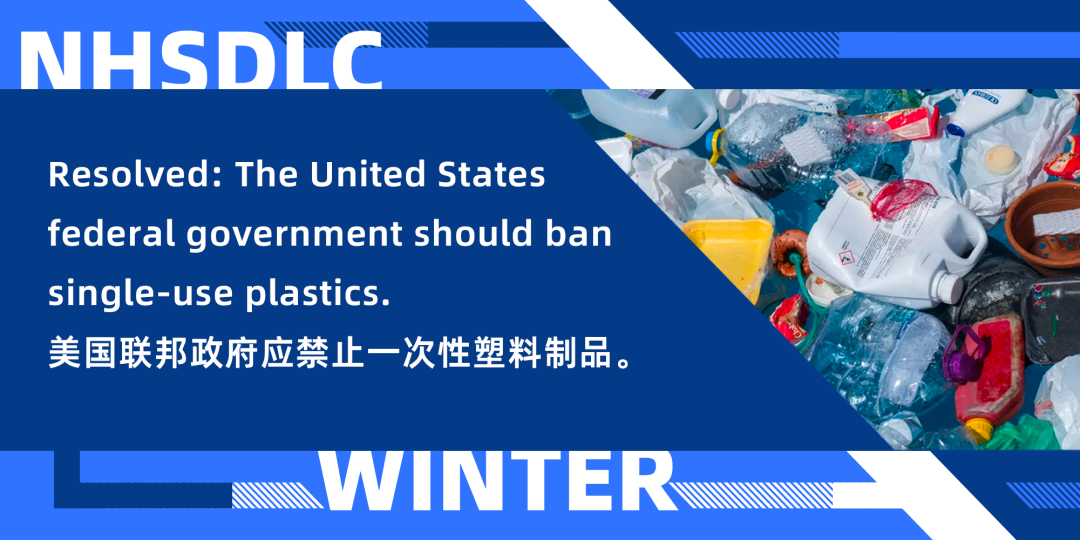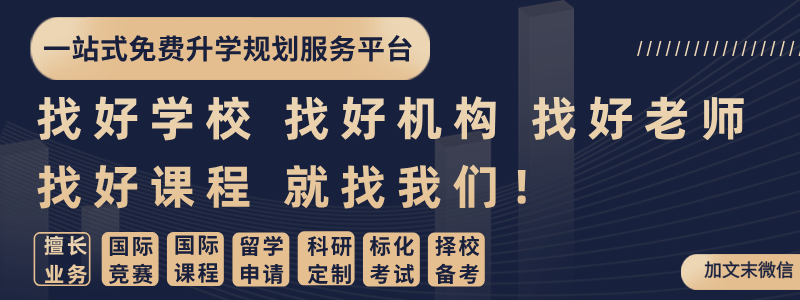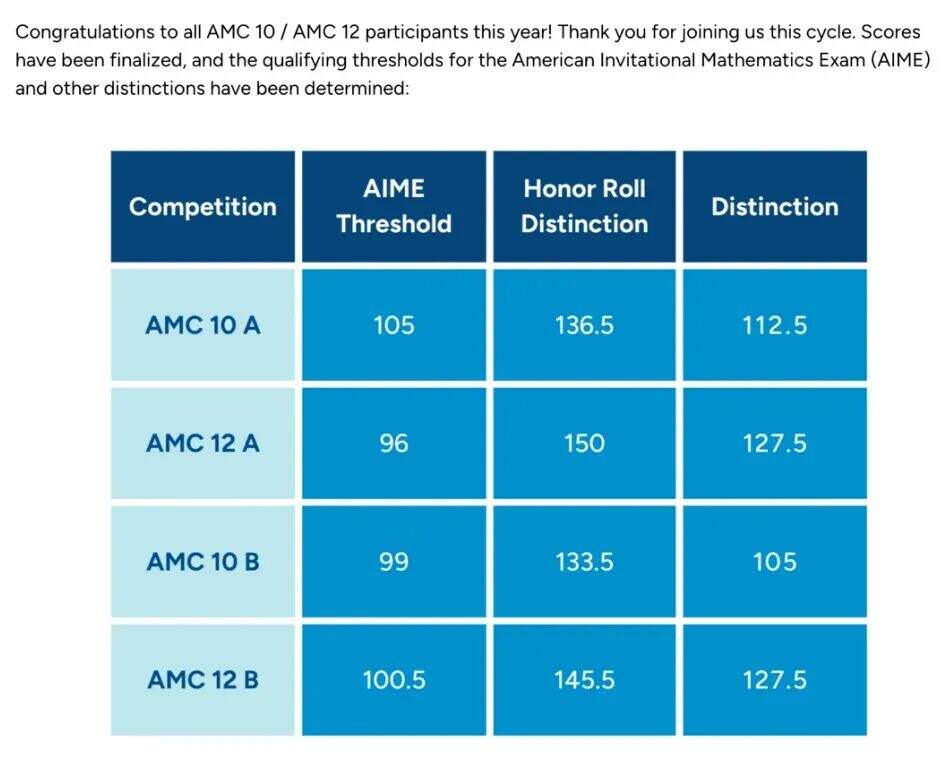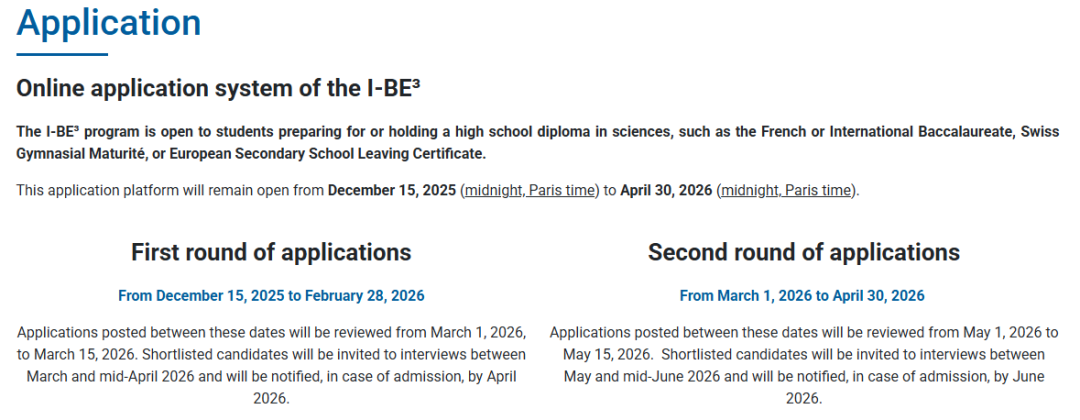下周末就要迎来冬天的第一场比赛 NHSDLC春节线上邀请赛 大家资料包都研究得怎么样了?
为了帮助大家更高效地备赛
今天我们邀请到了 资深教练Julian Gagnon 以及精英辩手Jack Li 带来2024冬季辩题解析

2024 NHSDLC WINTER 冬季辩题解析
本次辩题分析从正反双方的角度,围绕辩题的定义、辩论框架以及可能的论点展开。环境相关论点很明显将成为这场辩论中的关注焦点,涉及到化学污染、海洋、农业/土壤、气候变化等等领域,我们究竟该如何有战略地进行选取?
同时,辩题解析里还将为大家说明本次sample case的破题思路,选手们千万不要忘记查收今天次条的sample case~
辩题分析要点速览

The Constructive - Pro
正方观点
Even though I really like the Brazil topic and hoped it won, after doing my initial research on the single use plastics resolution, I ended up liking it a little more than I expected. Obviously there’s tons of information so researching will be easy. There’s decent ground for both sides of the debate. Finally, SUP are a ripe issue and the discussion is timely.
Pro teams
will pick and choose from a few different environment related contentions: chemical pollution, oceans, agriculture/soil, climate change, and water. Each of these contentions has their own strengths and weaknesses, but there are not that many contentions unrelated to the environment. You must think strategically about which environment related contention(s) to use.
The pro sample case
includes one long contention instead of two or three shorter ones. There are a number of reasons for this choice:
•one solid contention is better than two or three below average to average contentions;
•having a number of links allows you to spread a team out vertically (number of arguments within a contention) instead of horizontally (number of contentions);
•the con’s defense and offense might be stronger against other contentions;
•climate change is one of, if not the easiest, environmental impact to weigh;
•one of the links to climate change, environmental leadership, gives the pro a potential solution. However, I’m not trying to argue that all teams should always use a one contention case. I considered another version that would try to fit as many or all of the non-climate change contentions (chemical pollution, agriculture/soil, oceans, and water) as time allowed.
A chemical pollution contention with a general impact and two specific impact scenarios, agriculture/soil and water, could be really strong. Obviously plastic pollution in the oceans is another area with tons of evidence that could also be a good contention. Ultimately, on this topic 1st pro speeches have to make some choices…there isn’t enough time to cover everything.
Defining the Topic
Most teams would probably agree on the definition of the United States federal government including the legislative, executive, and judicial branches of the government in Washington D.C. As a result, it’s probablynot even worth defining. The definition of single use plastics is much more important and impactful to the topic, so teams are likely to define SUP instead.
Although a lot of people have pointed out the lack of consensus or misunderstanding of what is included and excluded by the term, there are a number of people who follow the UN definition of single use plastics. The UN, more or less, defines SUP as: plastics designed to be used one time, or a short period of time, before being thrown away or recycled. Some states in the US defined single use plastics by their size, however these regulations were circumvented by the plastics industry thickening their plastics.
Pro teams
should prepare lists of products that would be included, and what products, if any, would be excluded from the ban. Particular areas worthy of consideration are SUP in agriculture, construction, and fishing.
Framework
Pro teams could easily say the framework of the debate is utilitarianism or cost-benefit analysis and be done with it. However, some possible pro frameworks present no risk, easy way outs that could provide another way to win the debate. Even if the con wins their likely framework, cost-benefit analysis, the pro will likely include traditional impacts that can be weighed. As a result, the con doesn’t win the debate by winning their framework.
The precautionary principle might be a framework worth exploring. In the context of a ban on SUP, the precautionary principle would justify the ban even if there was no scientific consensus on the harms of plastics to humans and environment. The precautionary principle shifts the burden of proof onto the plastics industry, requiring them to prove the safety of plastics made with toxic chemicals. Shifting this burden of proof affects the con teams contentions. For example, con team arguments about the importance of SUP to agriculture or the economy do not prove that the plastics are safe.
Con teams need to invest time defending why cost-benefit analysis is the better framework for a ban on single-use plastics. At a minimum, summary speeches could concede the con cost-benefit analysis is the best framework and try to outweigh, and gain a time tradeoff in the process (con teams will spend time showing why CBA is good, which means less time attacking your contentions in rebuttal speeches). If con teams undercover framework and don’t provide justifications for the safety of plastics, pro teams have an easy path to victory.
Climate Change
The pro sample case includes four links between single use plastics and climate change. The first deals with production. Because plastics are made from fossil fuels, their production contributes to the climate crisis.
Pro teams should explain the lifecycle of plastics in terms of their contribution to greenhouse gases: from extraction, to production, to landfills or oceans, SUP add ghgs to the atmosphere.
Pro teams can even qualify the incredibly high rates of emissions from the plastics industry. Oceans are part of the carbon cycle and play a critical role as a sink. Unfortunately, SUP have been shown to impact phytoplankton, which are unable to sink and release their co2 as a result. In addition to disrupting carbon sinks, SUP may threaten whales, that also capture carbon. Finally, SUP floating in the ocean release methane, similar to landfills. They majority of SUP end up being thrown away in landfills. However, as sunlight increases the temperature of exposes SUP, they release powerful greenhouse gases like methane. Methane of course traps a lot more heat than co2, and landfills represent a significant source of total methane emissions. Finally, if the US federal government banned single use plastics, they would be enhance their environmental leadership. Currently the US does not have comprehensive, federal regulations of SUP. Many other countries around the world, including China and Europe, have already taken significant steps to limit plastic pollution. A ban would reverse the trend of the US lagging behind other nations on environmental issues. Many have called on the US to take the lead on plastic pollution, and increase international cooperation to end SUP. A study of the ban on plastics found even weak legislatures could gain environmental leadership from a ban. US environmental leadership would promote green innovation by positively effecting the performance of green innovation, mediating the relationship between leadership and products, and the relationship between leadership and strategy. Green innovation offers a partial solution to the climate crisis, despite losing momentum. A new wave of green innovation could reduce costs, leading to more technology transfers to developing nations. Banning SUP would incentivize R&D into environmentally friendly alternatives. Plastics will play a key role in meeting target goals of limiting temperature increases to 1.5 degrees celsius, the threshold for catastrophic climate change. If its contribution to the climate crisis is unregulated, the world will have a difficult time preventing a 2 degree rise in temperatures and might face an existential threat.
Chemical Pollution
All plastics, even newer biodegradable versions the con team is likely to talk about, include chemical that are toxic to humans. Most of these chemicals have never undergone safety tests. Many of the chemicals are known to cause significant health problems in humans. Low income communities of color that are located near manufacturing and storage facilities are disproportionately affected by chemical pollution. As single use plastics age and break apart into smaller and smaller pieces, micro and nano plastics enter the soil and eventual reach water tables. Plants and animals ingest the smaller pieces of plastic, which are then consumed by humans. In addition to the health of humans from exposure, pro teams could discuss the impact of micro and nano plastics on soil quality in the US. Studies are begging to link these smaller bits of plastics with soil quality. This could have huge implications on the US agriculture industry. In fact, even the con would likely agree that the US agriculture industry uses tons of SUP.
Pro teams could develop this scenario as a stand alone contention. Similarly, micro and nano plastics have also been linked to contamination of ground water and aquifers, a major source of drinking water for much of the world. Plastic pollution has even been found in bottled water. As with soil contamination, pro teams have the option of making water a contention by itself.
Oceans
Plastic pollution in the oceans is without a doubt the most well known potential harm of single use plastics. The amount of plastic pollution is growing, despite most people’s knowledge of the problem. Hundreds of marine species are threatened and hundreds of millions die every year.
Coral reefs, a vital marine ecosystem, are particularly vulnerable to plastic pollution. As with the agriculture and water scenarios from chemical pollution, pro teams could separate the fishing industry into its own contention. SUP are used in the fishing industry and could include certain types of fish nets (the EU ban on SUP covered fishing nets).
The combination of SUP pollution and SUP fishing nets pose a major threat to ocean health. With so many people worldwide dependent on fish as their main source of animal protein, collapse of the fishing industry would be devastating for billions of people.
US federal ban effective
Unlike many topics, a ban on single use plastics requires a debate over the effectiveness.
Pro teams would be wise to spend a little time defending how the ban could accomplish its goal, and why the US federal governmentshould pass a ban.
Ban Effective
If the framework for the debate is one of the precautionary principle, the question of effectiveness is less important that the question of plastic pollution’s impact on human health and the environment. New plastics would not be produced until proven safe. A ban on SUP would incentivize development of alternatives and control the source of plastics pollution- manufacturing. Even if the ban is not 100% effective, it represents a “step in the right direction.”
US federal government
Although the con does not have a strong link to federalism to pair with a states alternative, there is ample evidence to defend the effectiveness of state and local bans on plastics.
Con teams are unlikely to win that federal regulation would take away power from states since single use plastics are an issue of interstate commerce, and the federal government thus has jurisdiction to regulate SUP. State regulation of plastics lacks uniform regulation, with some states banning plastics while others have preempted regulations. Most call on congress to pass federal legislation banning SUP. Legislative regulation of plastics have broader laws and galvanize more public support for implementation compared to alternatives that bypass congress.
The Constructive - Con
反方观点
In the con sample case, I argued for a broad definition of single-use plastics by referencing what could be considered an authoritative source: ACS Chemical Reviews, a top journal in the field chemistry. This choice was motivated by the fact that numerous arguments on the con side hinge on the analysis of individual use cases of single-use plastics and the potential outcomes if these plastics were prohibited for those specific uses. Our aim is to prevent the pro side from selectively determining which single-use plastics are subject to a ban based on their interpretation of the resolution.
I did not specify a framework and defaulted to the standard framework of cost-benefit analysis. The first argument in the case serves a dual purpose, acting defensively to preempt the pro side's environmental impacts while also possessing its own offense. It primarily argues that in the foreseeable future, the issue of plastic pollution can be addressed through advancements in biodegradable plastics, countering the need for a ban on single-use plastics.
Debaters employing the biodegradable plastics argument should thoroughly prepare by reviewing numerous chemistry papers. They need to acquire a deep understanding of the properties of biodegradable plastics, including their decomposition time, the conditions influencing decomposition, the byproducts of decomposition, production costs, and the thermal and mechanical properties of various types of biodegradable plastics.
The second argument comprises two subpoints. Personally, I find the first subpoint, which addresses single-use plastics in agriculture, challenging to counter.
The pro side cannot advocate for reuse since plastic mulching films are prone to tearing and breaking during use. Additionally, arguing for recycling is not feasible as these films become contaminated by soil. Moreover, there are no viable alternative materials, as mulching films necessitate specific thermal and mechanical properties that can only be met by plastics. On the other hand, the subpoint about food safety has solid links, although the impacts may not be as compelling in comparison.
Defining the Topic
Con teams should argue for a broad definition of single use plastics and prevent the pro side from selectively determining which single-use plastics are subject to a ban based on their interpretation of the resolution.
Climate Change
CON can point to the biodegradable plastics argument in their sample case. Highlighting the new technology utilizing carbon dioxide for plastics production, CON can stress the potential environmental benefits and reduced carbon footprint.
Furthermore, CON can try to outweigh these impacts by evaluating alternatives to single-use plastics. Demonstrating evidence that alternative materials might release more greenhouse gases, CON can argue that a ban on single-use plastics may inadvertently lead to the adoption of alternatives with greater environmental consequences. This approach aims to emphasize the complexity of the issue and challenge the assumption that alternatives are inherently more sustainable.
Chemical Pollution
The con can assert that in certain applications, such as agriculture and food service, it is impractical or unsafe for items to be reused. Then the con can make the argument that the use of single-use items made with alternative materials, like paper, can lead to increased chemical pollution, providing a valid point of contention.
The issue of microplastics presents an inescapable challenge for the con side. Even bioplastics generate microplastics during decomposition. To counter this argument, the opposition can employ two strategies:
1. Minimize Pro's Solvency: Investigate and highlight the limited reduction in microplastics achievable through a ban on single-use plastics in the US. Showcase data on the marginal impact of such a ban in reducing the overall presence of microplastics.
2. Outweigh Microplastic Impacts: Emphasize other potential impacts or risks that may outweigh the concerns related to microplastics. This could include addressing broader environmental concerns, economic impacts, or public health considerations to create a comparative perspective.
Agriculture
In agriculture, single-use plastics are crucial for optimizing water use and boosting crop yield, as highlighted in the CON sample case. The study cited is specific and clear in quantifying the importance of these plastics in agriculture, making it straightforward to demonstrate that their positive impact outweighs any potential drawbacks.
Oceans
Estimates indicate that the United States generates between 40 to 52 million tons of plastic pollution annually, while the European Union contributes 53 million tons. In response to the argument concerning ocean pollution, the con can counter by adapting cards such as “the single-use plastics ban will decrease the EU’s contribution to plastic marine pollution by 5.5% which equates to a 0.06% decrease globally. It is concluded that the plastics ban will lead to only a small reduction of global plastic marine pollution” to the US.
Irreplaceability
Con should actively seek cases where single-use plastics seem indispensable. Agriculture has already been discussed; another area to explore is healthcare. Consider the implications for single-use medical devices and personal protective equipment (PPE) if there were a ban on single-use plastics.
Con can challenge pro on these specific use cases, prompting pro to respond by either interpreting the resolution in a nuanced way or presenting viable alternatives. This approach encourages a more comprehensive examination of the resolution's impact on various critical sectors.















